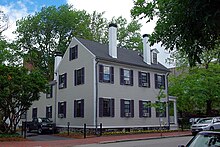This article has multiple issues. Please help improve it or discuss these issues on the talk page. (Learn how and when to remove these messages)
|
 Putnam House, 69 Brattle Street, was the headquarters of the program in the 1940s. Putnam House, 69 Brattle Street, was the headquarters of the program in the 1940s. | |
| Former names | Training Course in Personnel Administration, Management Training Program |
|---|---|
| Type | Academic program |
| Active | 1937–1963 |
| Parent institution | Radcliffe College, Harvard Business School |
| Affiliation | Harvard University |
| Location | Cambridge, Massachusetts, United States |
The Harvard-Radcliffe Program in Business Administration was a joint program of Radcliffe College and Harvard Business School intended to provide women with post-graduate education in business administration.
History
The Harvard-Radcliffe Program in Business Administration began in March 1937, as an eleven-month course Training Course in Personnel Administration, intended to prepare Radcliffe College alums for careers after graduation. From its earliest days, the program included two periods of field work, in which students worked in factories or in stores or business offices. The first class consisted of only five students and the original focus was on work in the field of education. The program was founded by Edith Stedman, director of Radcliffe College's Appointment Bureau; Stedman also served as the program's first director. In 1941, Anne Hood Harken took over as director; during her tenure, the program underwent significant changes, partly prompted by the exigencies of World War II and the increased opportunities for women to hold personnel jobs in industry and government. The program expanded to offer courses on administrative problems in industry; these classes, taught by the faculty of the Harvard Business School, had earlier only been given to men. Enrollment increased significantly with this new approach, with the class size growing to 30 students.
In 1944, T. North Whitehead became director. After World War II, to reflect the program's broader scope, its name was changed to the Management Training Program. Enrollment spiked briefly after World War II but began declining in the early 1950s. At this point the program was also running a deficit, and in 1951 the president and council of Harvard voted to discontinue the program in 1953. Harvard Business School agreed to take over the educational portion of the program as well as the financial responsibilities, with Radcliffe providing housing and classrooms and handling administrative functions. To cement this agreement, the program's name was changed to the Harvard-Radcliffe Program in Business Administration in 1956. However, the program offered by the Management Training Program differed significantly from the two-year program offered to men in the Business School; the Radcliffe Program lasted only one year and did not award degrees. Dudley Meek served as director from 1955 to 1958 and oversaw a revision of the curriculum, which was redesigned to be broader in scope.
In 1959, with enrollment in the program dropping and with increasing pressure to enroll women in the Business School, the faculty voted to admit graduates of the Harvard-Radcliffe Program to the second year of the MBA program. In 1962, a committee appointed by the Dean of the Business School recommended that the Harvard-Radcliffe program be discontinued. In December of that year, the faculty accepted the committee's recommendation and also voted to accept women into the full MBA program.
Alumnae
- Betty Jane Diener, academic administrator and politician
- Barbara Franklin, former U.S. Secretary of Commerce
- Barbara B. Kennelly, former congresswoman
- Patricia Ostrander
- Leslie Crocker Snyder, lawyer and former judge
References
- Bartlett, Sarah (March 24, 1991). "A Straight Arrow's Inexplicable Fall". New York Times. Retrieved 3 November 2015.
- HBS Library Exhibit
- Records of the Harvard-Radcliffe Program in Business Administration, 1936-1977 (inclusive), 1936-1963 (bulk): A Finding Aid. Schlesinger Library, Radcliffe Institute, Harvard University.